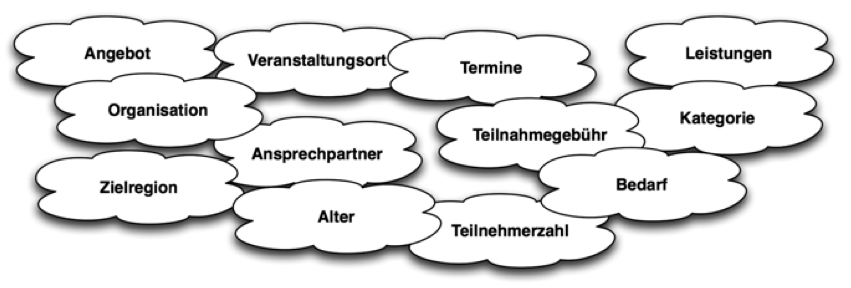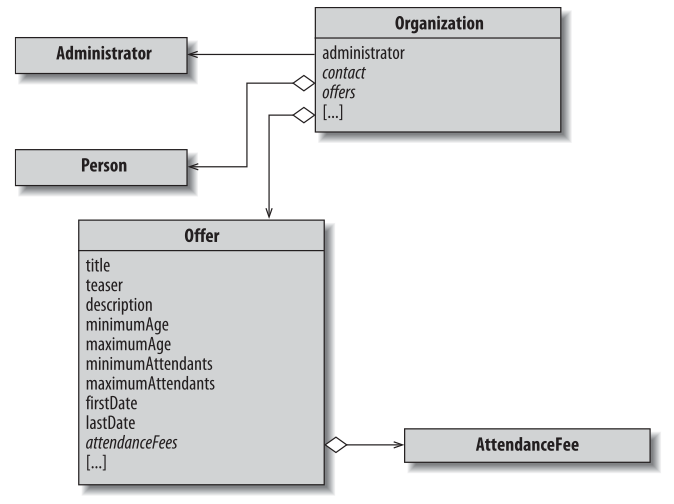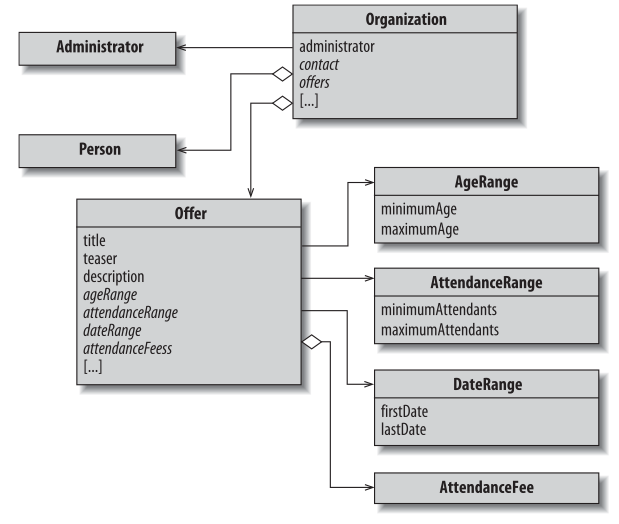Attention
TYPO3 v9 has reached its end-of-life September 30th, 2021 and is not maintained by the community anymore. Looking for a stable version? Use the version switch on the top left.
You can order Extended Long Term Support (ELTS) here: TYPO3 ELTS.
The application domain¶
The main difference to the common approach to develop an extension is the concentration to the domain of the client - in our case to the domain of the offer management inside the Stadtjugendrings Stuttgart. First the essential core terms are to be extracted with which the employees of the Stadtjugendring interact daily. Terms of the domain of the content management system (e.g. "list view" or "search") are not playing roles by this. After a first project meeting with the contact persons of the SJR following characteristics were defined:
Every member organization can edit their contact data via the front end.
Every member organization can add, edit and delete their offers. The offers can be searched by the users and filtered by several criteria. Filter criteria are specially:
the duration of validity of the offer
the target audience for which the offer is straightened (mostly the age span, but also physical handicapped, swimmer and so on)
the target area for which the offer may be for interest (one or more city districts, nationwide), as well as
a free selectable category to which the offer is counted among (e.g. "sport offer" or "spare time")
The offers are output in list form and single view in the front end.
A single organization can be shown with its offers in a view.
The offers can be collected to a flyer which contains all information to the offers.

Figure 5-1: The still incoherent terms of the domain¶
These terms are the result of a process. Some of them are modified many times during the discussions. So the first chosen term of vendor developed to the term organization. Thereby a part was that the domain of the offer management not exist isolated inside the SJR. It is in fact embedded in the whole business. And there the term of member organization (or short organization) make more sense.
Tip
This development of a common language of developers (also ourselves) and domain experts (also the employees of the SJR) maybe is the most important part of the Domain Driven Design. In the literature you find the slightly bulky term Ubiquitous Language. Requirement for this process is that the developer take care for contact with the domain experts. This is notably in bigger projects in many cases not the case. More about the development of an Ubiquitous Language you can read about in chapter 2 in the section "Develop a common language".
First of all the located rules and operations are fixed down on paper. Here is an excerpt of the list:
"An offer can be assigned to multiple townships if they are located in whose catchment area."
"An organization can be assigned with multiple contact persons."
"An offer can be assigned with a contact person. The contact persons of the organization are shown as selection."
"Is there an offer without a contact person, the main contact of the organization is mentioned."
"An offer can show different attendance fees (e.g. for member and non member)."
The terms and rules are taken in relationship now. From the past thoughts a first draft of the domain is made, which you can see in figure 5-2. Every rectangle emblematise an object of the domain. The lower half of the bin shows an extract of its properties. Properties in italic writing of a parent object are holding references to the child objects. The chaining lines with an arrow point to those parent child relations. An additional rhomb symbolized an aggregate, also a package of child objects.

Figure 5-2: First draft of the domain.¶
Tip
This figure was created by a drawing program. In the communication with the customer we are aware of using drawing programs or UML tools, which would be constrict the workflow in this phase. Simple hand drafts are enough and are more accessible for the customer as technical diagrams.
Tip
You should have noticed that we make a big point of using a common language between developer and domain experts at the begin of the section and now we use permanent english descriptions for classes, methods and properties. Our experience told us that in the life time of an extension also developer get in contact with the source code, which are not potent to understand other languages as their own language and english. To not exclude them without change effort we choose english as lingua franca of the source code. This is especially true for extensions that - like our case - are made public via the extension repository.
Let us improve the first draft of the domain model. The offer has several property pairs, that belong together:
minimumAgeandmaximumAge(the minimal and maximal age)minimumAttendantsandmaximumAttendants(the minimal and maximal count of attendees)firstDateandlastDate(date of beginning and end)
These property pairs are subject to own rules, that are not
part of a single property. The minimal age limit (minimumAge)
for example should not be greater than the maximum age limit
(maximumAge). The observation of this rule can be done by the
offer itself by a corresponding validation. But it rather belongs to the
property pair. We store each property pair in an own domain object:
AgeRange, AttendanceRange and
DateRange. The outcome of this is the optimized second draft
(see figure 5-3).

Figure 5-3: Second draft of the domain.¶
The specific domain objects have a common property, they have a lower
and upper value. With this we can insert a class hierarchy in which the
three domain objects succeed these common property from a domain object
RangeConstraint. This has two generic properties:
minimumValue and maximumValue (see figure
5-4).

Figure 5-4: Third draft of the domain.¶
Our domain model has reached a certain level of maturity. Of course there is certain space for more optimization. The risk exists, that we lose in the details, which will be irrelevant in a later revision. We suggest that you first implement a basic model and then - with additional knowledge of the yet unknown details of the model - improve it step by step. Let's start with our first lines of code.
